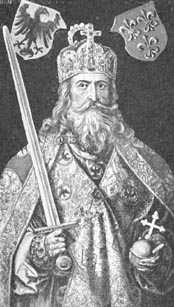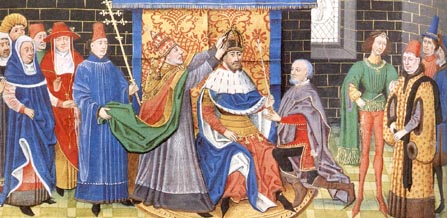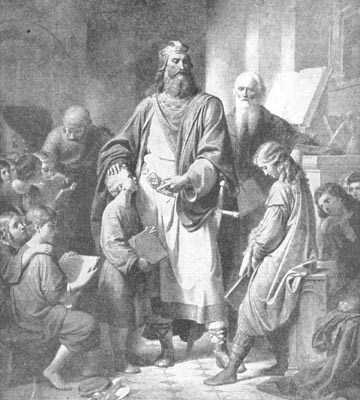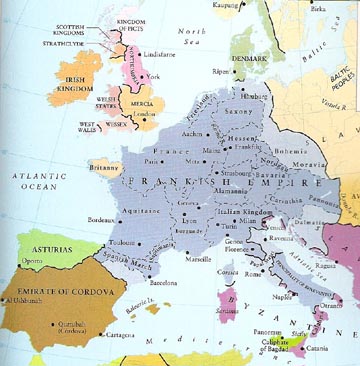Charlemagne, Emperor of the West
 When Pépin the Short died in 768, the Frankish
lands were divided according to ancient Frankinsh law and tradition between
Pépin's sons Carloman and Charles. During the next three years
until Carloman's death in 771, relations between the two brothers were
sometimes strained. In 774, Charles "the Great" or Karolus Magnus,
more widely known as Charlemagne, conquered Lombardy and confirmed his
father's donation of the Papal States. Charlemagne added Bavaria to his
realm, and eventually defeated the Saxons and forced them to convert to
Christianity. Charlemagne also waged war in Spain. He was returning
from an expedition there in 778 when a mountain people called the Basques
ambushed and wiped out his rear guard. This incident became the subject
of the famous epic poem The Song of Roland. In the
poem, however, the ambushers were the Moors, a Muslim people who ruled
Spain.
When Pépin the Short died in 768, the Frankish
lands were divided according to ancient Frankinsh law and tradition between
Pépin's sons Carloman and Charles. During the next three years
until Carloman's death in 771, relations between the two brothers were
sometimes strained. In 774, Charles "the Great" or Karolus Magnus,
more widely known as Charlemagne, conquered Lombardy and confirmed his
father's donation of the Papal States. Charlemagne added Bavaria to his
realm, and eventually defeated the Saxons and forced them to convert to
Christianity. Charlemagne also waged war in Spain. He was returning
from an expedition there in 778 when a mountain people called the Basques
ambushed and wiped out his rear guard. This incident became the subject
of the famous epic poem The Song of Roland. In the
poem, however, the ambushers were the Moors, a Muslim people who ruled
Spain.
Charlemagne was
crowned Emperor of the Romans by Pope Leo III on Christmas Day, 800.
For further details of Charlemagne's conquests and contributions, see the
references below.
 |
The Coronation of
Charlemagne
by Pope Leo III
December 25, 800
|
More is known
about Charlemagne than most mediæval rulers because of a biography
written by Einhard, a friend of his son Louis the Pious. This biography
describes Charlemagne as more than six feet tall, with piercing eyes, fair
hair, a thick neck, and a potbelly. He was strong, fond of exercise,
and had an alert mind and a forceful personality. Charlemagne could
read and speak Latin, the language of educated people of the time.
However, he never learned to write it.
 |
Charlemagne
and the Scholars
Charlemagne also improved education
and culture by establishing a school at his palace in Aachen. This
palace school attracted the best teachers and students in Europe.
It educated clergymen, thus strengthening the church, and trained teachers
for schools throughout the empire. Scholars at the schools collected
and copied ancient Roman manuscripts, which otherwise would have been lost
forever. |

|
The Frankish Empire
of
Charlemagne
at its greatest extent
circa 814
(shown coloured blue)
|
Click to return to the Charlemagne
Page or use your browser's back button.
Please visit the Sewell
Genealogy Site Map for other pages in this series.
This summary was written in July 2006 by Robert
Sewell using sources including the following:
World Book Millenium 2000 Deluxe Edition,
© 1999 World Book Inc., © IBM Corp.
Barnes and Hudson, The History Map of Europe,
New York, 1998
Microsoft Encarta Encyclopædia 99,
© 1993-1998 Microsoft Corporation
Norman F. Cantor (ed.) The Encyclopædia of
the Middle Ages, New York, 1999
Berhard Grun, The Timetables of History,
New York, 1991
The Book of History (18 Volumes), London,
1914
 When Pépin the Short died in 768, the Frankish
lands were divided according to ancient Frankinsh law and tradition between
Pépin's sons Carloman and Charles. During the next three years
until Carloman's death in 771, relations between the two brothers were
sometimes strained. In 774, Charles "the Great" or Karolus Magnus,
more widely known as Charlemagne, conquered Lombardy and confirmed his
father's donation of the Papal States. Charlemagne added Bavaria to his
realm, and eventually defeated the Saxons and forced them to convert to
Christianity. Charlemagne also waged war in Spain. He was returning
from an expedition there in 778 when a mountain people called the Basques
ambushed and wiped out his rear guard. This incident became the subject
of the famous epic poem The Song of Roland. In the
poem, however, the ambushers were the Moors, a Muslim people who ruled
Spain.
When Pépin the Short died in 768, the Frankish
lands were divided according to ancient Frankinsh law and tradition between
Pépin's sons Carloman and Charles. During the next three years
until Carloman's death in 771, relations between the two brothers were
sometimes strained. In 774, Charles "the Great" or Karolus Magnus,
more widely known as Charlemagne, conquered Lombardy and confirmed his
father's donation of the Papal States. Charlemagne added Bavaria to his
realm, and eventually defeated the Saxons and forced them to convert to
Christianity. Charlemagne also waged war in Spain. He was returning
from an expedition there in 778 when a mountain people called the Basques
ambushed and wiped out his rear guard. This incident became the subject
of the famous epic poem The Song of Roland. In the
poem, however, the ambushers were the Moors, a Muslim people who ruled
Spain.


